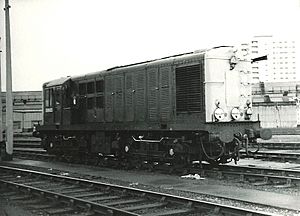British Rail Class 16 facts for kids
Quick facts for kids NBL Type 1British Rail Class 16 |
|
 |
|
| No. D8403 in green livery with all-yellow front end at Stratford MPD in 1966 | |
| Power type | Diesel-electric |
|---|---|
| Builder | North British Locomotive Company |
| Serial number | 27671–27680 |
| Build date | 1958 |
| Total production | 10 |
| UIC classification | Bo′Bo′ |
| Gauge | 4 ft 8 1⁄2 in (1,435 mm) |
| Wheel diameter | 3 ft 7 in (1.092 m) |
| Minimum curve | 3.5 chains (70.41 m) |
| Wheelbase | 28 ft 6 in (8.69 m) |
| Length | 42 ft 6 in (12.95 m) |
| Width | 8 ft 8+1⁄2 in (2.654 m) |
| Height | 12 ft 8 in (3.861 m) |
| Locomotive weight | 68 long tons (69 t; 76 short tons) |
| Fuel capacity | 400 imp gal (1,800 L; 480 US gal) |
| Prime mover | Paxman 16YHXL |
| Displacement | 78.4 L (4,780 cu in) |
| Generator | GEC WT 881 (plus GEC auxiliary generator |
| Traction motors | 4 x GEC WT 441, nose suspended, with single reduction gear drive |
| Cylinders | 16 |
| Cylinder size | 7 in (178 mm) bore 7+3⁄4 in (197 mm) stroke |
| Transmission | Diesel electric |
| Multiple working | ● Red Circle |
| Power output | Engine: 800 hp (597 kW) At rail: 627 hp (468 kW) |
| Tractive effort | Maximum: 42,000 lbf (186.8 kN) |
| Train heating | None; through steam pipe |
| Locomotive brakeforce | 31 long tons-force (310 kN) |
| Train brakes | Vacuum |
| Axle load class | Route availability 4 |
| Retired | 1968 |
| Disposition | All scrapped |
The British Rail Class 16 was a type of diesel locomotive used in the United Kingdom. It was also known as the North British Type 1. These locomotives were part of a big plan by British Rail in 1955 to update their train system.
These trains were smaller compared to other types. They were mainly used for moving goods on local railway lines.
Contents
What Was the Class 16?
The Class 16 was a diesel-electric locomotive. This means it used a diesel engine to power a generator, which then made electricity. This electricity powered motors that turned the wheels.
Built for a New Era
In the 1950s, British Railways wanted to replace old steam trains with newer, more modern diesel and electric ones. This big change was called the "Modernisation Plan." The Class 16 was one of the new designs ordered to help with this plan.
Who Built Them?
These locomotives were built by the North British Locomotive Company. This company was located in Glasgow, Scotland. They built all ten of the Class 16 locomotives in 1958.
How Many Were Made?
Only ten Class 16 locomotives were ever built. Their special numbers were D8400 to D8409.
What Were They Used For?
The Class 16 trains were designed to pull freight (goods) on shorter journeys. They were not meant for fast passenger trains or very heavy, long-distance freight. Their smaller size made them good for local jobs.
Why Are They Gone?
Sadly, the Class 16 locomotives did not last very long. They were all taken out of service and scrapped (taken apart) by 1968. This means they were only in use for about ten years. They were replaced by other, more successful diesel locomotives.

